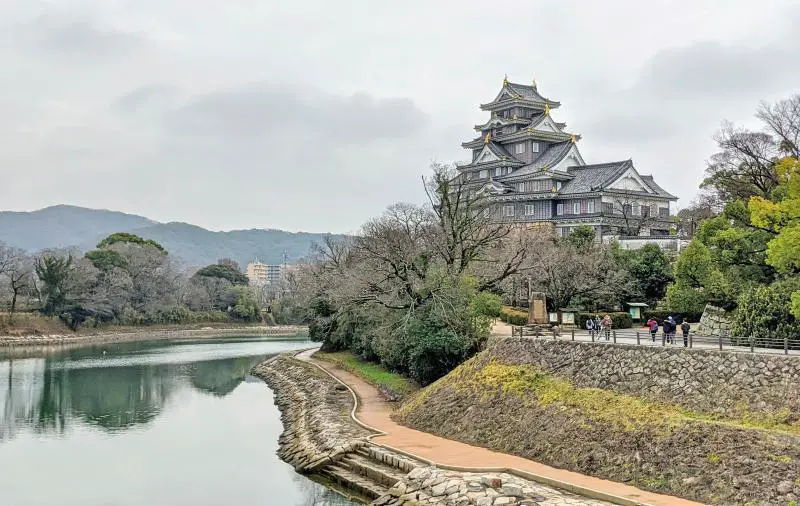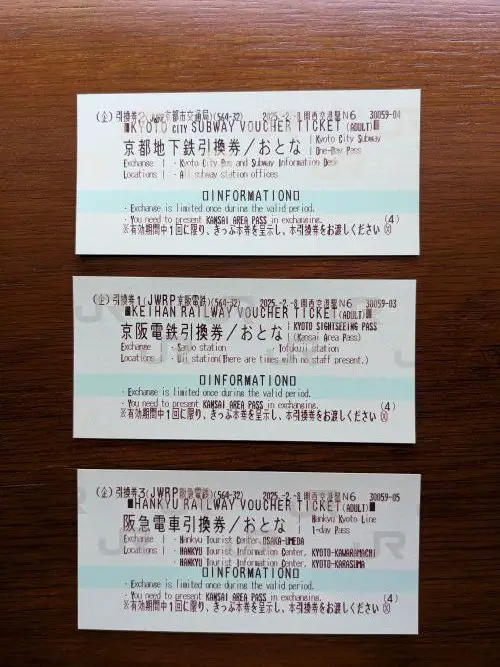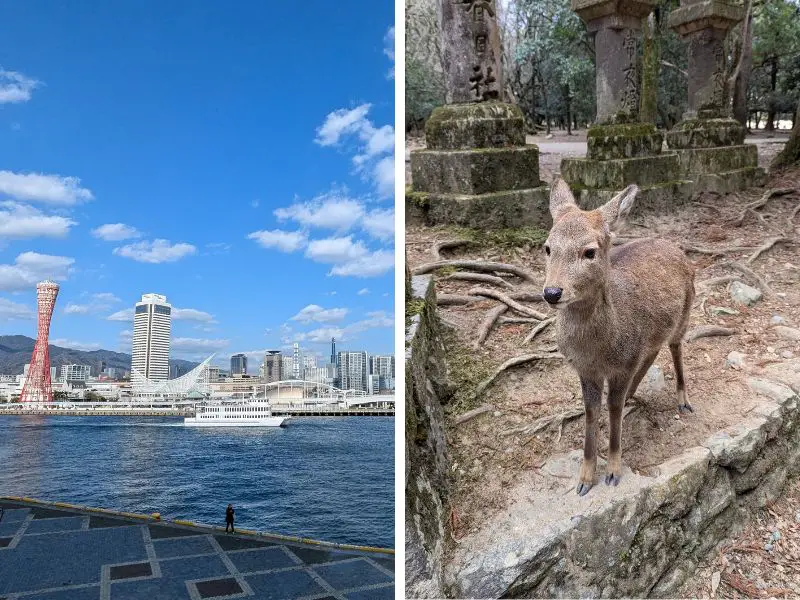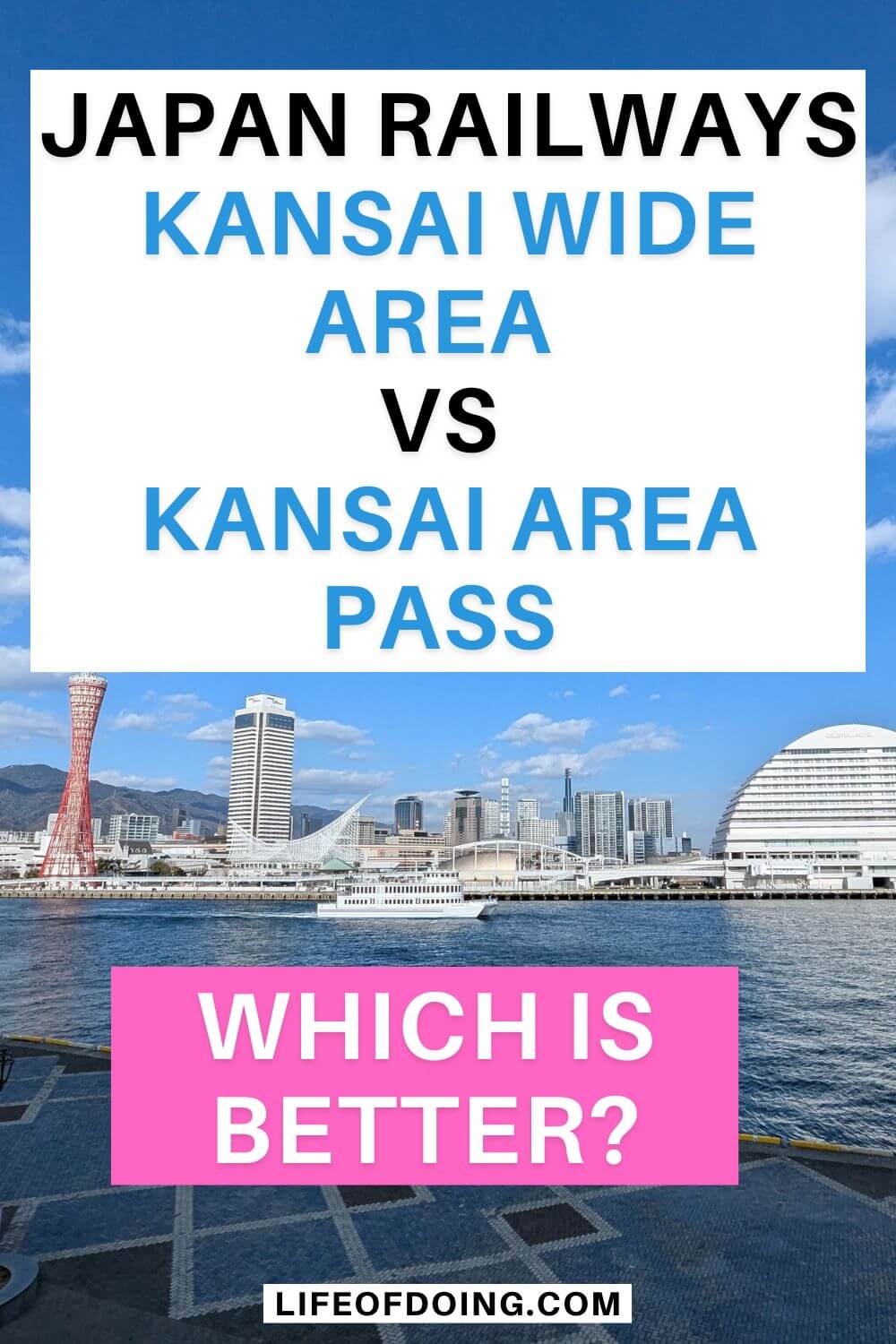Japan Railways (JR), one of the main train operators in Japan, offers many rail passes for international tourists. The rail passes are a fantastic way to explore a region or the entire country for a certain amount of time and at a reasonable price.
Since Justin and I live in Vietnam, it’s convenient for us to fly to Kansai Airport at least 2 times a year. This year, we planned a trip with my mother-in-law to the Kansai area (Osaka, Kyoto, Kobe, and Nara). We wanted to see what train passes were available.
During my research, I came across two JR passes to consider – JR West Kansai Wide Area and JR West Kansai Area Pass. The names were almost identical except for one word, yet I wasn’t sure which pass to choose.
To lessen your confusion, I researched and determined the differences between the JR West Kansai Wide Area and JR West Kansai Area Pass, and which one would be better to use.
*Disclaimer: This post contains affiliate links. If you click on them and make a purchase, we receive a small commission. There is no additional cost to you. Appreciate the support.
JR West Kansai Area Wide Area Pass Overview
This pass is suitable for travelers who want to cover a wider area of Kansai, such as Okayama. It also includes selected shinkansen (high-speed bullet trains) and limited express trains, which can expedite travel time.
Time Duration & Cost
5 Days: 12,000 yen (Adults), 6,000 yen (Children)
Adult riders need to spend at least 2,400 yen per day over 5 days to break even for the pass. Children need to spend 1,200 yen per day.
Areas Covered
This pass covers the extended West Kansai area – Osaka, Kyoto, Nara, Wakayama, Shirahama, Tsuruga, Otsu, Himeji, Kobe, Okayama, Takamatsu, Tottori, Kinosaki Onsen, Amanohashidate, and Kansai Airport.

Okayama Castle is one of the places to visit in Okayama
Features
The pass includes JR West local train lines, rapid express, special rapid, limited express, JR Shikoku local lines, and some Shinkansen lines.
The pass includes reserved seating.
You can ride Limited Express trains such as Haruka Airport Express (the adorable Hello Kitty train), Kuroshio, Konotori, Super Hakuto, and more.
The cost of the Haruka Airport Express varies depending on the ending location. From the Airport to Kyoto, the cost is 3,640 yen for a reserved seat.
The Sanyo Shinkansen, including Nozomi and Mizuho, between Shin Osaka and Okayama Station, is also included in the pass. Nozomi and Mizuho are considered the fastest bullet trains compared to taking the slightly slower Sakura Shinkansen.
The Shin Osaka to Okayama Shinkansen cost is between 6140 to 6460 yen if taking the Sakura or Nozomi trains. It takes only 48 to 50 minutes to travel between the cities.
Click here to see a full list of the limited express trains and shinkasens with reserved seating.
Note: Tickets can be booked at the ticket machines before boarding for reserved seating in ordinary cars. You can reserve up to 6 times from the ticket reservation machine. For the 7th time and beyond, you’ll need to go to the ticket office to reserve.
If you want to ride the Green Car (first class), then an additional fee is required.
The local JR West Bus, such as in Kyoto, is included in the pass.
JR West Kansai Area Pass Overview
This pass is suitable for those who travel shorter distances and rely on local and express trains to travel around.
We used this pass so you can read the full review here.
Time Duration & Cost
You can choose the number of days for the pass:
- 1 Day: 2,800 yen (Adults), 1,400 yen (Children 6-11 years old)
- 2 Days: 4,800 yen (Adults), 2,400 yen (Children)
- 3 Days: 5,800 yen (Adults), 2,900 yen (Children)
- 4 Days: 7,000 yen (Adults), 3,500 yen (Children)
This pass rewards you for longer durations. For example, adults need to spend only 1,750 yen per day for a 4 day pass. Children need to spend 875 yen per day.

This is what the 4 day Kansai Area Pass looks like
Areas Covered
The pass includes Osaka, Kyoto, Nara, Wakayama, Tsuruga, Otsu, Kobe, Himeji, and Kansai Airport.
Features
The pass includes all JR train lines in the designated region, such as local, rapid, express, and limited express.
This includes the Airport Express Haruka Train (Hello Kitty train) with reserved seating up to 2 times.
Unfortunately, shinkansen trains are not included in the pass.
But, the Kansai Area Pass includes a free one day pass for the other transportation operators – Kyoto City Subway, Keihan Railway, and Hankyu Railway.

Here are the three non-JR railway vouchers that you’ll receive with the Kansai Area Pass
The Kyoto City Subway also includes the local JR bus line in Kyoto. The bus pass is super helpful since many temples are not near a train line.
You’ll receive 3 vouchers for these railways when you receive the West Kansai Area Pass. Then, the vouchers need to be redeemed at specific exchange sites to receive the 1 day pass.
These 1 day passes can only be used in the Kyoto area during the time frame of the West Kansai Area Tourist Pass. So, you cannot use them the day after your JR pass has ended.
What are the Major Differences Between the Two Passes?
The per-day cost is higher for the Kansai Wide Area Pass than the Kansai Area Pass.
As mentioned earlier, the Kansai Wide Area Pass would need to spend 2,400 yen per day for 5 days, while the Kansai Area Pass is 1,750 yen per day for 4 days for Adults.
You can travel to more places in Kansai with the Kansai Wide Area Pass.
Osaka, Kyoto, Nara, Wakayama, Tsuruga, Himeji, Otsu, Kobe, Okayama, and Kansai Airport can be accessed with both passes.
Yet, Shirahama, Okayama, Takamatsu, Tottori, Kinosaki Onsen, and Amanohashidate are additional places to visit with the Kansai Wide Area Pass.
One high-speed bullet trains (shinkansen) is only available for the Kansai Wide Area Pass.
The Shin Osaka to Okayama Shinkansen takes between 48 to 50 minutes, depending on which Shinkansen train is taken.
You can reserve seats up to 6 times for limited express trains with the Kansai Wide Area Pass. The Wide Area Pass only allows 2 reserved seats for the Hello Kitty Haruka Airport Express train.
The free one-day passes for Kyoto City Subway, Keihan Railway, and Hankyu Railway are only for the Kansai Area Pass. If you would like to use these other transportation options and have the Kansai Wide Area Pass, then you’ll need to buy individual tickets or use a transportation card, such as Pasmo, Suica, or ICOCA.
Which Is Better for Travelers?
Verdict: It depends on your travel schedule, where you’ll visit, and your budget. Either pass would be convenient to use for the JR lines.
PRO TIP: We recommend creating a schedule of the places that you’ll visit and the nearest JR train station. Then you can calculate the cost between the starting and ending stations by using the JR West Timetable and Route Finder. Afterward, you can calculate the total cost of the train rides you’ll take and determine which pass is better for you. You may even decide that you don’t get a pass since you won’t break even with the cost.
We used the 4 day Kansai Area Pass as it met our needs for traveling in Osaka, Kyoto, Nara, and Kobe. We traveled with my mother-in-law, and the pass was the cheaper option. We exceeded the value of the pass since we took the JR line as much as we could, including short 1 to 2 minute train rides.
If we plan to visit Okayama from Shin Osaka Station in the future, then we would consider the Kansai Wide Area Pass. The one-way cost of the Shinkansen is already half of the pass value, so this pass is an excellent option. A round trip would break even for the pass.
Where to Buy the Pass
Buy the pass online and receive an e-voucher. You can buy on the JR Pass website or from a third-party vendor, such as Klook. We bought this exact pass on Klook and received a free e-SIM card to use in Japan. So, you may get an extra perk by buying through Klook.
How to Redeem the Pass
Step 1: Print the e-voucher.
Step 2: Once you arrive in Japan, visit a JR Ticket Office to redeem the e-voucher for a physical pass. Show your passport. We went to the Kansai Airport JR Ticket Office to redeem the e-voucher.
Step 3: Receive your pass and insert it into the turnstile to enter and leave the station.
Enjoy unlimited rides on the JR train lines and local bus lines during your pass duration.
Final Thoughts
We hope you feel more comfortable with choosing the appropriate JR pass for your next trip to Kansai! Feel free to ask any questions in the comment section regarding these passes.
If you’re interested in reading our other train pass reviews, check out our posts below:
Like this post? Save it to your Pinterest board.


